The Acropolis of Athens Old Museum
IntroductionThe Museum existing until lately on the Acropolis rock was considered among the most important ones in the world and definitely the most important one as far as the History of European Art is concerned. It was built on the Acropolis Hill in 1874, in such a way that it would not aesthetically interfere with the Temples, nor be visible from anywhere within the city of Athens.
The excavations that followed, toward the end of the 19th century, unearthed a wealth of finds which were impossible to exhibit in the limited space of the Museum. Thus, the inscriptions, bronzes, clay objects, and a variety of other items were kept in the National Archaeological Museum, where they were originally taken for conservation. The situation was aggravated after all the marble pieces were removed from the Parthenon Friezes (that is, what was left over after Elgin's plunder) and were put in the museum, together with the Caryatids (the marble statues of the women supporting the roof of the south porch of the Erechtheion), all of which were removed to be kept in an air-tight window containing nitrogen, so as to stop air pollution from deteriorating the marble surfaces.
The collections of the museum included:
Sculptural offerings of the Archaic period
Pediments of temples dated to the Archaic period
Archaic Horsemen
Sculptures of the "Severe" style
Pediments and metopes from the Parthenon
The Parthenon frieze
The Erechtheion frieze
Parapets of the Athena Nike temple
Frieze of the Athena Nike temple
The Caryatids
Clay figurines and vases from the sanctuary of the Nymphs.
Everyone was eagerly anticipating the completion of the new Acropolis Museum, for the total wealth of finds related to the Acropolis and the Parthenon to finally be exhibited in the best possible way (combining location, lighting, space, air filtering and thematic consistency), and thus deprive the descendants of Lord Elgin of all plausible excuses to insist that the Parthenon Marbles continue to be kept separated from the rest of their like and the Parthenon remain in its mutilated state.
During 2008, the exhibits of this Museun were transferred to the New Museum, the erection of which was completed. Three huge cranes were used to carry all the heavy marble statues and exhibits, a total of some 4,500 artifacts from the old, cramped Acropolis museum, a task that was the biggest airlift of antiquities in Greek history. It was the first time the artifacts — some of which are considered among the most important works of antiquity — were moved from the very Acropolis Rock. This transfer was completed in the end of spring but putting up the exhibits in their right place would take a lot longer.
We thought that the present Album would become useless after the New Museum's inauguration. Nevertheless, the decision of the museum authorities to prohibit taking photographs of the exhibits in their new surrounding created more problems than the ones it was supposed to solve. We admit that the decision was well meant, but, with all due respect, we would like to point out that times have changed; we are afraid that whatever is not shown online cannot achieve the level of promotion that it may be worthy of. We managed, though, to get a number of photos of the exhibits, as the decision was taken a couple of weeks after the museum's inauguration. We are working on them and will do our best to put them up as soon as possible. But, in our effort to best present the exhibits, we are sorry to have to use some of the photos taken at the Old Acropolis Museum. Until the New Acropolis Museum album is online, please enjoy the marvellous artifacts at their old "home".
(Photos: Michael Tziotis)
Select Page of the Album:
Click on any of the pictures to enlarge.
Gallery V: Τhe 'Gigantomachia' PedimentStatues from the pediment of the archaic temple of Athena erected by the sons of Peisistratos about 520 B.C. The subject was the Gigantomachia, battle of Gods against the Giants. In the middle is Athena, the rest of the figures are Giants.
The pediment sculpture belongs to the sculptural decoration of the Old Temple of Athena, which stood on the foundations discovered south of the Erechtheion. In the past it was suggested that the temple had a still more ancient construction phase, in which the poros exhibits Gallery II belong. The marble sculptures in this gallery, according to this theory, are dated to a major reconstruction works program that took place around 525 B.C. when the sons of Peisistratos were in power. Modern theories suggest that the marble temple was the result of one only construction program in the last decade of the 6th century B.C., that is when a democratic government was established in Athens.
The temple was dedicated to Athena Polias and housed the cult statue of the goddess. In 480 B.C. the Persians destroyed the temple.
The sculptures, made of Parian marble, were carved fully in the round, an innovation in architectural sculpture introduced in late archaic times.
The east pediment of the temple represents the Gigantomachia, that is the battle of the Olympian gods against the Giants. The partial restoration of the composition displays the following figures, mended up from fragments: Athena attacking the giant Enkelados (one foot is preserved), a giant falling to the ground and two half kneeling giants in the pediment corners.
The west pediment, of which only small fragments have survived, represented two lions savaging a bull. The foreparts of two horses derive from a frontal representation of a four horse chariot, perhaps of Zeus, which, according to an early view, would have occupied the center of the Gigantomachia pediment, whereas a recent conjecture places the chariot in the center of the west pediment.
The dynamic modelling of the figures and their vigorous movements create a striking effect, as well as the rendering of the details picked out in color, such as Athena’s aegis. This is the work of a great sculptor who remains unknown. Scholars have attributed the sculpture to various famous sculptors of the archaic period, Antenor and Endoios being the leading candidates.
The frieze blocks representing Hermes(Akr 1343) and a charioteer (Akr 1342, Gallery IV) have also been assigned to the temple. The painted marble sime with lion head waterspout (Akr 69) crowned a corner of one of the pediments.
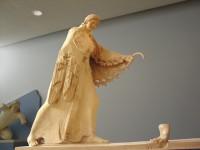
Akr 631. The East Pediment of the Archaic Temple of Athena
Statues from the pediment of the archaic temple of Athena erected by the sons of Peisistratos about 520 B.C. The subject was the Gigantomachia, battle of Gods against the Giants. In the middle is Athena, the rest of the figures are Giants. To the left of this picture you can see one of them; the one at the other corner is shown in another photo further down this page. |
|
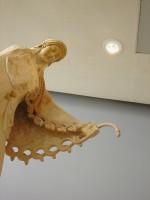
Akr 631. The East Pediment of the Archaic Temple of Athena
Athena detail |
|
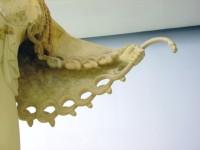
Akr 631. The East Pediment of the Archaic Temple of Athena
Close up on the Athena statue |
|
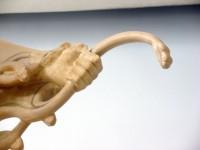
Akr 631. The East Pediment of the Archaic Temple of Athena |
|
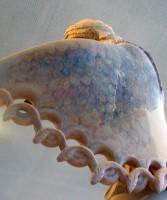
Akr 631. The East Pediment of the Archaic Temple of Athena
One cannot help trying to imagine the magnificence and splendor of this masterpiece in its original setup, more than 2500 years ago. |
|
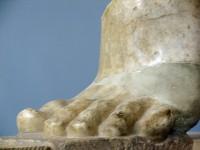
Akr 631. The East Pediment of the Archaic Temple of Athena (Detail of Titan's foot) |
|
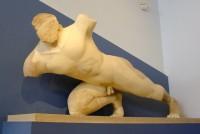
Akr 631. Τhe East Pediment of the Archaic Temple of Athena (The Figure of a Giant) |
|
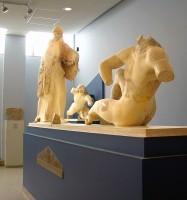
Akr 631. The East Pediment of the Archaic Temple of Athena |
|
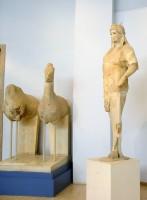
Akr 631. The East Pediment of the Archaic Temple of Athena
This photo is taken in the same Gallery Nr V and shows the Antenor Kore to the right, shown in a picture of her own in the previous album page, and the two statues of the horses that are believed, by some researchers, to have occupied the center of this Pediment composition; this theory is outlined in the following photo. |
|

Akr 631. The East Pediment of the Archaic Temple of Athena
This photo is of a drawing outlining the positioning of the two horses in the middle of the pediment in question |
|
Select Page of the Album:
|
|



